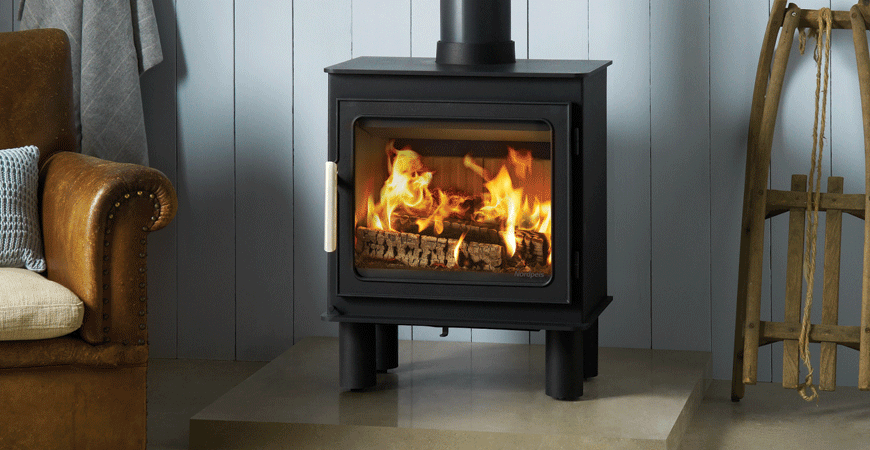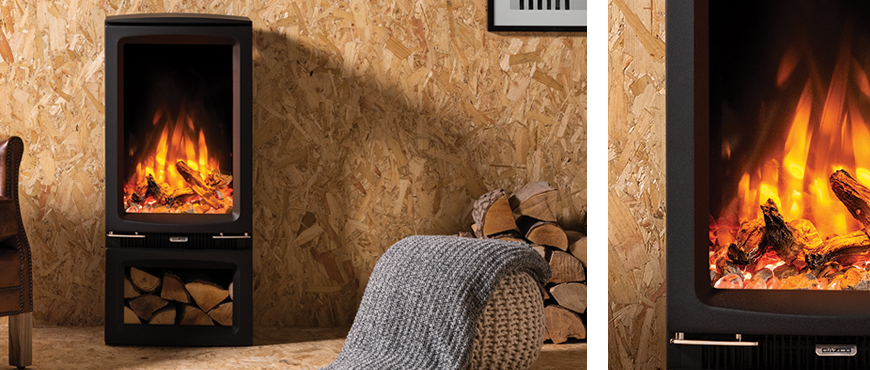
In short, yes. But there are key considerations and factors that you will need to be aware of. Here, we’ve answered your key questions with this comprehensive guide to installing a wood burner in a shed.
Yes, but there are some key considerations to be aware of that we have explained below. For many of us, a shed is so much more than just somewhere to store the lawn mower. Some sheds are now kitted out to be a sanctuary in our own garden – but you may be wondering how to heat it. This advice will also assist you for heating a summer house, or garden room.
For installation, the most important regulation is BS8303:2018. BS8303:2018 is the British Standard for Installation of domestic heating and cooking appliances burning wood and solid mineral fuels, and provides all required guidance for your installer – your retailer/installer should have a copy of the standard.
 Wood burning stove shown: Nordpeis Bergen
Wood burning stove shown: Nordpeis Bergen
Building Regulation Approved Document Part J also needs to be followed, as it provides guidance on the safe installation and use of appliances that produce heat, including chimneys and flues. It is also essential to observe the manufacturer’s instructions for installation, which includes relevant distance to combustibles. A heat shield may be required behind the stove, which protects your shed wall from the heat produced by the wood burner. You will probably be required to fit non-combustible surfaces to the walls adjacent and behind the stove.
If you have opted for an appliance suitable for a 12mm decorative hearth installation, this will make fitting the stove much easier, rather than having to implement a 125mm thick hearth. It also gives you more scope to use different materials for the hearth, such as tempered glass, whereas a 125mm thick constructional hearth tends to be made from concrete.
It is also important to remember local air regulations in place, such as Smoke Control Zones. If you live in a Smoke Control Area, you can only burn wood if using a DEFRA-exempt appliance. Find out more about Smoke Control Areas on this useful article.
As with all installations, we recommend fitting a carbon monoxide detector and smoke alarm in the shed for your safety. This will provide ample warning and protection, keeping you and anyone who uses this space safe.
We recommend a twin wall pre-insulated flue system, such as Stovax Professional XQ. Depending on the natural draft provided by the flue, a powered flue fan may be required as it is highly likely that the flue will terminate at a height of 2 meters or less (Building Regulations suggest a minimum height of 4.5 meters for natural draft flues). A powered flue fan sits at the top of the flue, and are electrically powered to suck air up the flue. This works particularly well if you are without a natural flue draft, as you can artificially create one.
Use the usual room calculation as most appliances will burn hotter than their nominal output when the controls are more open. This calculation is worked out as follows:
As a rough guide, to achieve a comfortable room temperature of around 21°C when the air temperature outside is 0°C, you will need approximately 1kW of heat output for every 14 cubic meters of space. Measure the length, width and height of your room and multiply the three figures together. Divide the sum by 14, and this figure will indicate the kW you require.
However, it is best to ask your local retailer for expert advice, as there may be variables that affect what amount of heat output you need. It is best to limit the stove to 7kW and no more. If you install a stove that is too large, it will be difficult to run it properly, and this can lead to quickly sooting up your flue. Most appliances that have a larger output require some substantial distance to combustibles as well.
Your installer may refer to HETAS’ BS8511:2010 regulations, which offers the code of practice for the installation of solid fuel heating and cooking appliances in small craft. This is a very good point of reference for the more unusual installation.
If there is power in the shed, it may be a good idea to install a dehumidifier to keep the air dry. Alternatively, use a desiccating dehumidification chemical such as silica gel, which will reduce the need to run a dehumidifier constantly. When the stove is not being used, leave all air controls fully open to allow natural airflow through the appliance. If your shed is very damp and you do not take these steps to protect your appliance, it is possible that in time your log burner will start to show signs of rust damage.
It is important to note that if the shed is a workshop, do not be tempted to burn any treated off-cuts. Treated wood, such as furniture, produce chemicals in the flue gases such as arsenic, and other harmful gases that contribute to pollution and reduce air quality. Most wood burners are not built to burn sawdust either – for this purpose, a specialist ‘workshop stove’ must be installed instead. As with all wood burners, only burn well-seasoned or kiln dried wood, and remember to register your new appliance to get the maximum warranty available to you.

Here are the considerations to make when looking at installing an electric stove or gas log burner in your shed.
It is possible to have an electric appliance in your shed, provided your shed has had a suitable wiring installation that has been signed off by a qualified electrician.
It is also important to ensure that any draughts are sealed up, as these could cause some stoves to operate functions such as the Open Window Detection feature, which will switch off the heat.
Be careful to follow the installation instructions, being particularly mindful of the insulated and flammable materials, and any clearances that need to be observed.
If your shed is not insulated, this will make the heating of this space less efficient, making the stove work harder to maintain the temperature. However, it will not affect anything beyond an increased electricity bill! If your shed is prone to damp, using the stove on a timer is actually a good way to reduce or even eliminate this dampness. To be able to do this safely, ensure that there are no leaks in your shed, or any risks of water having any contact with the appliance. Be sure to leave a suitable gap between the electric stove and any walls that are prone to dampness.
Above all, make sure that your electrical installation is safe, and signed off. Keep your shed tidy and organised to avoid the risk of anything falling or coming into the clearance spaces around the fire.
When it comes to installing a gas log burner in your shed, it is very much about considering the shed environment on a case by case basis. Your installer will need to make a judgement on considerations such as:
Some sheds are more akin to a domestic living space, with full insulation and sealed from the elements. If this is the case, it may be a completely different assessment made by your installer.
Contact your local retailer to chat more about your options!
Sign up to our newsletter and receive the latest news and updates, including product launches, offers and promotions, exclusive giveaways and competitions, as well as seasonal tips and advice.
Subscribe Now!
Hi I want to buy a installation kit to fit a stove into a wooden shed. I have a hearth already. Can you please advise where we can buy one? Thanks
Thank you for sharing this information about can i install a log burner in my shed. It was useful and interesting. You indeed have written it in a layman way so that anyone can understand and work accordingly. You have done a great job… Great post!!
I’m interested in a log burner for my summer house and want to now which one is recommended
Hi Alan, there’s too many options to recommend any as it really depends on your personal preference, style and heat output requirements. The best thing to do would be to speak to your local Stovax retailer who will carry out a site survey and help you find the right model for you – https://www.stovax.com/information/find-a-retailer/